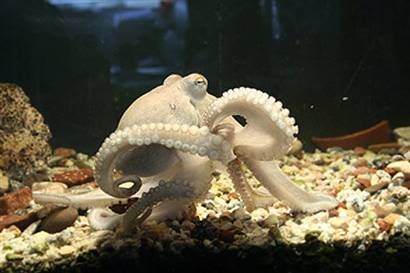Pulpos -Flexibilidad de los tentáculos (II)-
Published Monday, June 12, 2006 by Spyder | E-mail this postSiguiendo el artículo de ayer, este otro de la Scientific American donde se explica la investigación propulsada por el biólogo Binyamin Hochner para explicar el movimiento de los tentáculos del pulpo. Para ello lo que hacen es poner unos electrodos sobre los tentáculos de los pulpos para comprobar las reacciones de estos a los estímulos eléctricos. Las conclusiones demuestran que el movimiento del pulpo es la consecuencia de una muy buena solución evolutiva
Study Shows How Octopus, Ever the Impersonator, Turns Tentacle into Jointed Limb
By David Biello
By David Biello
The octopus is the ultimate softie. Lacking a skeleton, the animal can take any number of forms and can move its tentacles in any direction. But when performing point-to-point movements, such as those used during feeding, the octopus adopts a decidedly humanlike approach: it forms an elbow and other joints out of the tentacle grasping the food item and tips the treat back into its mouth. New research shows how the pliant animals create such a stiff limb.
 Biologist Binyamin Hochner and an international team of scientists wired the tentacles of five octopuses with electrodes to determine exactly how the creatures control the formation of a working replica of a three-jointed limb. The researchers found that the octopuses contract muscles via two signals: one from the base of the tentacle and one from the tip. The two impulses propagate toward each other and the elbow forms where the two meet.
Biologist Binyamin Hochner and an international team of scientists wired the tentacles of five octopuses with electrodes to determine exactly how the creatures control the formation of a working replica of a three-jointed limb. The researchers found that the octopuses contract muscles via two signals: one from the base of the tentacle and one from the tip. The two impulses propagate toward each other and the elbow forms where the two meet.
 Biologist Binyamin Hochner and an international team of scientists wired the tentacles of five octopuses with electrodes to determine exactly how the creatures control the formation of a working replica of a three-jointed limb. The researchers found that the octopuses contract muscles via two signals: one from the base of the tentacle and one from the tip. The two impulses propagate toward each other and the elbow forms where the two meet.
Biologist Binyamin Hochner and an international team of scientists wired the tentacles of five octopuses with electrodes to determine exactly how the creatures control the formation of a working replica of a three-jointed limb. The researchers found that the octopuses contract muscles via two signals: one from the base of the tentacle and one from the tip. The two impulses propagate toward each other and the elbow forms where the two meet. This dual signal allows the tentacle to form the perfect joint to bring a succulent tidbit to its mouth and shows how muscle can function just as well as bone as a structural element. It also suggests that articulated limbs with joints may be the best evolutionary solution for such motion, the researchers argue. After all, the flexible octopus has unlimited options for that movement. The research appears in today's Current Biology.
La fotografía es del propio Binyamin Hochner
Labels: Características



0 Responses to “Pulpos -Flexibilidad de los tentáculos (II)-”
Leave a Reply